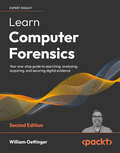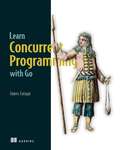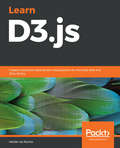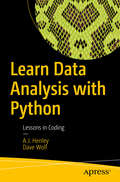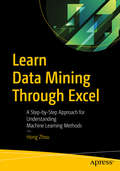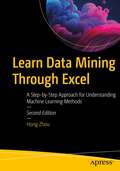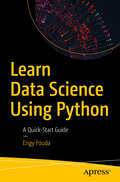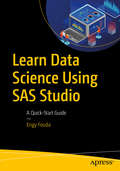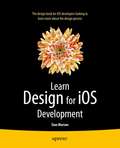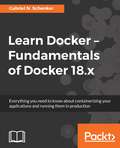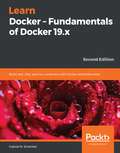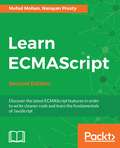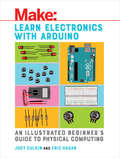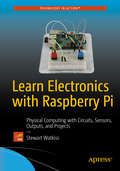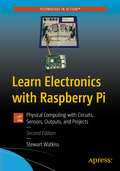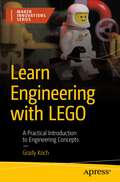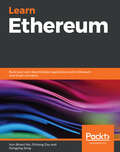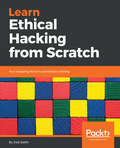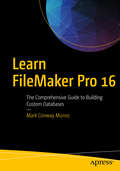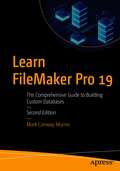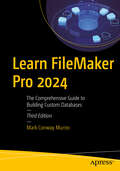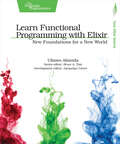- Table View
- List View
Learn Computer Forensics: Your one-stop guide to searching, analyzing, acquiring, and securing digital evidence, 2nd Edition
by William OettingerLearn Computer Forensics from a veteran investigator and technical trainer and explore how to properly document digital evidence collectedKey FeaturesInvestigate the core methods of computer forensics to procure and secure advanced digital evidence skillfullyRecord the digital evidence collected and organize a forensic examination on itPerform an assortment of Windows scientific examinations to analyze and overcome complex challengesBook DescriptionComputer Forensics, being a broad topic, involves a variety of skills which will involve seizing electronic evidence, acquiring data from electronic evidence, data analysis, and finally developing a forensic report.This book will help you to build up the skills you need to work in a highly technical environment. This book's ideal goal is to get you up and running with forensics tools and techniques to successfully investigate crime and corporate misconduct. You will discover ways to collect personal information about an individual from online sources. You will also learn how criminal investigations are performed online while preserving data such as e-mails, images, and videos that may be important to a case. You will further explore networking and understand Network Topologies, IP Addressing, and Network Devices. Finally, you will how to write a proper forensic report, the most exciting portion of the forensic exam process.By the end of this book, you will have developed a clear understanding of how to acquire, analyze, and present digital evidence, like a proficient computer forensics investigator.What you will learnExplore the investigative process, rules of evidence, legal process, and ethical guidelinesUnderstand the difference between sectors, clusters, volumes, and file slackValidate forensic equipment, computer program, and examination methodsCreate and validate forensically sterile mediaGain the ability to draw conclusions based on the exam discoveriesRecord discoveries utilizing the technically correct terminologyDiscover the limitations and guidelines for RAM Capture and its toolsExplore timeline analysis, media analysis, string searches, and recovery of deleted dataWho this book is forThis book is for IT beginners, students, or an investigator in the public or private sector. This book will also help IT professionals who are new to incident response and digital forensics and are looking at choosing cybersecurity as their career. Individuals planning to pass the Certified Forensic Computer Examiner (CFCE) certification will also find this book useful.
Learn Computer Vision Using OpenCV: With Deep Learning CNNs and RNNs
by Sunila GollapudiBuild practical applications of computer vision using the OpenCV library with Python. This book discusses different facets of computer vision such as image and object detection, tracking and motion analysis and their applications with examples. The author starts with an introduction to computer vision followed by setting up OpenCV from scratch using Python. The next section discusses specialized image processing and segmentation and how images are stored and processed by a computer. This involves pattern recognition and image tagging using the OpenCV library. Next, you’ll work with object detection, video storage and interpretation, and human detection using OpenCV. Tracking and motion is also discussed in detail. The book also discusses creating complex deep learning models with CNN and RNN. The author finally concludes with recent applications and trends in computer vision.After reading this book, you will be able to understand and implement computer vision and its applications with OpenCV using Python. You will also be able to create deep learning models with CNN and RNN and understand how these cutting-edge deep learning architectures work.What You Will LearnUnderstand what computer vision is, and its overall application in intelligent automation systemsDiscover the deep learning techniques required to build computer vision applicationsBuild complex computer vision applications using the latest techniques in OpenCV, Python, and NumPyCreate practical applications and implementations such as face detection and recognition, handwriting recognition, object detection, and tracking and motion analysisWho This Book Is ForThose who have a basic understanding of machine learning and Python and are looking to learn computer vision and its applications.
Learn Concurrent Programming with Go
by James CutajarConcurrency doesn&’t need to be confusing. Start writing concurrent code that improves performance, scales up to handle large volumes of data, and takes full advantage of modern multi-processor hardware.Too many developers think concurrency is extremely challenging. Learn Concurrent Programming with Go is here to prove them wrong! This book uses the easy-to-grasp concurrency tools of the Go language to demonstrate principles and techniques, steadily teaching you the best practices of effective concurrency. Techniques learned in this book can be applied to other languages. In Learn Concurrent Programming with Go you will learn how to: Implement effective concurrency for more responsive, higher performing, scalable software Avoid common concurrency problems such as deadlocks and race conditions Manage concurrency using goroutines, mutexes, readers-writer locks, and more Identify concurrency patterns such as pipelining, worker pools, and message passing Discover advantages, limits, and properties of parallel computing Improve your Go coding skills with advanced multithreading topics Concurrent programming allows multiple tasks to execute and interact simultaneously, speeding up performance and reducing user wait time. In Learn Concurrent Programming with Go, you&’ll discover universal principles of concurrency, along with how to use them for a performance boost in your Go applications. Expert author James Cutajar starts with the basics of modeling concurrency in your programs, demonstrates differences between message passing and memory sharing, and even introduces advanced topics such as atomic variables and futexes. About the technology You can improve almost any application&’s performance and responsiveness by introducing concurrency into the codebase. This book will show you how! It starts with the basics of concurrent programming and builds your skills step by step by exploring scenarios you&’ll face every day as a developer. Author James Cutajar explains each aspect of concurrency in plain language using the intuitive features baked into the Go language. About the book Learn Concurrent Programming with Go provides a practical, hands-on introduction to creating software for modern multiprocessor systems. In it, you&’ll learn how to divide larger programming tasks into independent parts that can run simultaneously. You&’ll use the Go language to implement common concurrency patterns by utilizing readers-writer locks, semaphores, message passing, and memory sharing. The skills you learn will easily transfer to other languages. What's inside Prevent deadlocks and race conditions Go concurrency features like goroutines, mutexes, channels, and more Concurrency patterns including pipelining and worker pools About the reader For programmers with basic knowledge of Go or another C-style language. No experience in concurrent programming required. About the author James Cutajar has been programming for more than 20 years. He&’s an open source contributor, blogger, tech evangelist, Udemy instructor, and author. Table of Contents PART 1 FOUNDATIONS 1 Stepping into concurrent programming 2 Dealing with threads 3 Thread communication using memory sharing 4 Synchronization with mutexes 5 Condition variables and semaphores 6 Synchronizing with waitgroups and barriers PART 2 MESSAGE PASSING 7 Communication using message passing 8 Selecting channels 9 Programming with channels PART 3 MORE CONCURRENCY 10 Concurrency patterns 11 Avoiding deadlocks 12 Atomics, spin locks, and futexes
Learn D3.js: Create interactive data-driven visualizations for the web with the D3.js library
by Helder da RochaExplore the power of D3.js 5 and its integration with web technologies for building rich and interactive data visualization solutionsKey FeaturesExplore the latest D3.js 5 for creating charts, plots, and force-directed graphicsPractical guide for creating interactive graphics and data-driven apps with JavaScriptBuild Real-time visualization and transition on web using SVG with D3.jsBook DescriptionThis book is a practical hands-on introduction to D3 (Data-driven Documents): the most popular open-source JavaScript library for creating interactive web-based data visualizations. Based entirely on open web standards, D3 provides an integrated collection of tools for efficiently binding data to graphical elements. If you have basic knowledge of HTML, CSS and JavaScript you can use D3.js to create beautiful interactive web-based data visualizations.D3 is not a charting library. It doesn’t contain any pre-defined chart types, but can be used to create whatever visual representations of data you can imagine. The goal of this book is to introduce D3 and provide a learning path so that you obtain a solid understanding of its fundamental concepts, learn to use most of its modules and functions, and gain enough experience to create your own D3 visualizations. You will learn how to create bar, line, pie and scatter charts, trees, dendograms, treemaps, circle packs, chord/ribbon diagrams, sankey diagrams, animated network diagrams, and maps using different geographical projections. Fundamental concepts are explained in each chapter and then applied to a larger example in step-by-step tutorials, complete with full code, from hundreds of examples you can download and run. This book covers D3 version 5 and is based on ES2015 JavaScript.What you will learnLearn to use D3.js version 5 and web standards to create beautiful interactive data-driven visualizations for the webBind data to DOM elements, applying different scales, color schemes and configuring smooth animated transitions for data updatesGenerate data structures and layouts for many popular chart formats Apply interactive behaviors to any chartCreate thematic maps based on GIS data using different geographical projections with interactive behaviors Load, parse and transform data from JSON and CSV formatsWho this book is forThe book is intended for web developers, web designers, data scientists, artists, and any developer who wish to create interactive data visualization for the Web using D3. The book assumes basic knowledge of HTML, CSs, and JavaScript.
Learn Data Analysis with Python: Lessons In Coding
by Dave Wolf A. J. HenleyGet started using Python in data analysis with this compact practical guide. This book includes three exercises and a case study on getting data in and out of Python code in the right format. Learn Data Analysis with Python also helps you discover meaning in the data using analysis and shows you how to visualize it. Each lesson is, as much as possible, self-contained to allow you to dip in and out of the examples as your needs dictate. If you are already using Python for data analysis, you will find a number of things that you wish you knew how to do in Python. You can then take these techniques and apply them directly to your own projects.If you aren’t using Python for data analysis, this book takes you through the basics at the beginning to give you a solid foundation in the topic. As you work your way through the book you will have a better of idea of how to use Python for data analysis when you are finished.What You Will LearnGet data into and out of Python codePrepare the data and its formatFind the meaning of the dataVisualize the data using iPythonWho This Book Is For Those who want to learn data analysis using Python. Some experience with Python is recommended but not required, as is some prior experience with data analysis or data science.
Learn Data Mining Through Excel: A Step-by-Step Approach for Understanding Machine Learning Methods
by Hong ZhouUse popular data mining techniques in Microsoft Excel to better understand machine learning methods.Software tools and programming language packages take data input and deliver data mining results directly, presenting no insight on working mechanics and creating a chasm between input and output. This is where Excel can help.Excel allows you to work with data in a transparent manner. When you open an Excel file, data is visible immediately and you can work with it directly. Intermediate results can be examined while you are conducting your mining task, offering a deeper understanding of how data is manipulated and results are obtained. These are critical aspects of the model construction process that are hidden in software tools and programming language packages.This book teaches you data mining through Excel. You will learn how Excel has an advantage in data mining when the data sets are not too large. It can give you a visual representation of data mining, building confidence in your results. You will go through every step manually, which offers not only an active learning experience, but teaches you how the mining process works and how to find the internal hidden patterns inside the data.What You Will LearnComprehend data mining using a visual step-by-step approachBuild on a theoretical introduction of a data mining method, followed by an Excel implementationUnveil the mystery behind machine learning algorithms, making a complex topic accessible to everyoneBecome skilled in creative uses of Excel formulas and functionsObtain hands-on experience with data mining and ExcelWho This Book Is ForAnyone who is interested in learning data mining or machine learning, especially data science visual learners and people skilled in Excel, who would like to explore data science topics and/or expand their Excel skills. A basic or beginner level understanding of Excel is recommended.
Learn Data Mining Through Excel: A Step-by-Step Approach for Understanding Machine Learning Methods
by Hong ZhouUse popular data mining techniques in Microsoft Excel to better understand machine learning methods. Most software tools and programming language packages take data input and deliver data mining results directly, presenting no insight on working mechanics and creating a chasm between input and output. This is where Excel can help, and this book will show you exactly how. This updated edition demonstrates how to work with data in a transparent manner using Excel. When you open an Excel file, data is visible immediately and you can work with it directly. You’ll see how to examine intermediate results even as you are still conducting your mining task, offering a deeper understanding of how data is manipulated, and results are obtained. These are critical aspects of the model construction process that are often hidden in software tools and programming language packages. Over the course of Learn Data Mining Through Excel, you will learn the data mining advantages the application offers when the data sets are not too large. You’ll see how to use Excel’s built-in features to create visual representations of your data, enabling you to present your findings in an accessible format. Author Hong Zhou walks you through each step, offering not only an active learning experience, but teaching you how the mining process works and how to find hidden patterns within the data. Upon completing this book, you will have a thorough understanding of how to use an application you very likely already have to mine and analyze data, and how to present results in various formats. What You Will Learn Comprehend data mining using a visual step-by-step approachGain an introduction to the fundamentals of data miningImplement data mining methods in ExcelUnderstand machine learning algorithmsLeverage Excel formulas and functions creativelyObtain hands-on experience with data mining and Excel Who This Book Is For Anyone who is interested in learning data mining or machine learning, especially data science visual learners and people skilled in Excel who would like to explore data science topics and/or expand their Excel skills. A basic or beginner level understanding of Excel is recommended.
Learn Data Science Using Python: A Quick-Start Guide
by Engy FoudaHarness the capabilities of Python and gain the expertise need to master data science techniques. This step-by-step book guides you through using Python to achieve tasks related to data cleaning, statistics, and visualization. You’ll start by reviewing the foundational aspects of the data science process. This includes an extensive overview of research points and practical applications, such as the insightful analysis of presidential elections. The journey continues by navigating through installation procedures and providing valuable insights into Python, data types, typecasting, and essential libraries like Pandas and NumPy. You’ll then delve into the captivating world of data visualization. Concepts such as scatter plots, histograms, and bubble charts come alive through detailed discussions and practical code examples, unraveling the complexities of creating compelling visualizations for enhanced data understanding. Statistical analysis, linear models, and advanced data preprocessing techniques are also discussed before moving on to preparing data for analysis, including renaming variables, variable rearrangement, and conditional statements. Finally, you’ll be introduced to regression techniques, demystifying the intricacies of simple and multiple linear regression, as well as logistic regression. What You’ll Learn Understand installation procedures and valuable insights into Python, data types, typecasting Examine the fundamental statistical analysis required in most data science and analytics reports Clean the most common data set problems Use linear progression for data prediction Who This Book Is For Data Analysts, data scientists, Python programmers, and software developers new to data science.
Learn Data Science Using SAS Studio: A Quick-Start Guide
by Engy FoudaDo you want to create data analysis reports without writing a line of code? This book introduces SAS Studio, a free data science web browser-based product for educational and non-commercial purposes. The power of SAS Studio comes from its visual point-and-click user interface that generates SAS code. It is easier to learn SAS Studio than to learn R and Python to accomplish data cleaning, statistics, and visualization tasks. The book includes a case study about analyzing the data required for predicting the results of presidential elections in the state of Maine for 2016 and 2020. In addition to the presidential elections, the book provides real-life examples including analyzing stocks, oil and gold prices, crime, marketing, and healthcare. You will see data science in action and how easy it is to perform complicated tasks and visualizations in SAS Studio.You will learn, step-by-step, how to do visualizations, including maps. In most cases, you will not need a line of code as you work with the SAS Studio graphical user interface. The book includes explanations of the code that SAS Studio generates automatically. You will learn how to edit this code to perform more complicated advanced tasks. The book introduces you to multiple SAS products such as SAS Viya, SAS Analytics, and SAS Visual Statistics. What You Will Learn Become familiar with SAS Studio IDEUnderstand essential visualizationsKnow the fundamental statistical analysis required in most data science and analytics reportsClean the most common data set problemsUse linear progression for data predictionWrite programs in SASGet introduced to SAS-Viya, which is more potent than SAS studio Who This Book Is For A general audience of people who are new to data science, students, and data analysts and scientists who are experienced but new to SAS. No programming or in-depth statistics knowledge is needed.
Learn Design for iOS Development
by Sian MorsonLearn Design for iOS Development is for you if you're an iOS developer and you want to design your own apps to look great and be in tune with the latest Apple guidelines. You'll learn how to design your apps to work with the exciting new iOS 7 look and feel, which your users expect within their latest apps. Learn Design for iOS Development guides you through the design processes that you can apply to design your own apps brilliantly. We'll start at the idea stages of your apps, and you'll see how you can analyze and apply the right design patterns for every app you are coding, use wireframing tools to take your ideas forward, and use Photoshop to create the visual assets you want to look great in your app. You'll understand why Apple have made the decisions they've made with the new iOS 7 interface and new HIG guidelines, and from that insight you'll be able to vision and create your own apps, on iPhones and iPads, that work perfectly within the new iOS 7 interface. What you'll learn How to build apps that work within the exciting new iOS 7 design paradigm How to design great looking apps that your users will find a pleasure to use The deeper design elements you can apply to your apps What is and how to use Apple's Human Interface Guidelines (HIG) How to go beyond Apple's HIG guidelines to create innovative apps Design pattern basics and how you can use them How to use wireframes to create your app How to use Adobe Photoshop to create the visual assets for your apps How to create your app's icon and additional graphics for the App Store Extra considerations for iPad app design considerations Common design best practices and mistakes Who this book is for This book is for iOS developers who know that they can code well, but want to know how they can build apps to also have brilliant designs. This book is also a guide for all iOS app developers who want their apps to look contemporary within the new iOS 7 interface guidelines. Table of Contents 1. You've Got an Idea for an iPhone App, Now What? 2. iOS: What You Need to Know 3. iOS 7 and Flat Design 4. Getting to Know the User Interface of the iPhone and iPad Design Considerations 5. Mobile Design Patterns 6. Using Wireframes to Design Your App 7. Designing Your Visual Assets with Adobe Photoshop 8. Creating Your App Icon and Additional Graphics for the App Store 9. Finalizing Your Assets for App Development 10. Design Best Practices and Mistakes to Avoid
Learn Docker - Fundamentals of Docker 18.x: Everything you need to know about containerizing your applications and running them in production
by Gabriel Nicolas SchenkerEnhance your software deployment workflow using containersKey Features●Get up-and-running with basic to advanced concepts of Docker●Get acquainted with concepts such as Docker containers, Docker images, orchestrators and so on.●Practical test-based approach to learning a prominent containerization toolBook DescriptionDocker containers have revolutionized the software supply chain in small and big enterprises. Never before has a new technology so rapidly penetrated the top 500 enterprises worldwide. Companies that embrace containers and containerize their traditional mission-critical applications have reported savings of at least 50% in total maintenance cost and a reduction of 90% (or more) of the time required to deploy new versions of those applications. Furthermore they are benefitting from increased security just by using containers as opposed to running applications outside containers.This book starts from scratch, introducing you to Docker fundamentals and setting up an environment to work with it. Then we delve into concepts such as Docker containers, Docker images, Docker Compose, and so on. We will also cover the concepts of deployment, orchestration, networking, and security. Furthermore, we explain Docker functionalities on public clouds such as AWS.By the end of this book, you will have hands-on experience working with Docker containers and orchestrators such as SwarmKit and Kubernetes.What you will learn●Containerize your traditional or microservice-based application●Share or ship your application as an immutable container image●Build a Docker swarm and a Kubernetes cluster in the cloud●Run a highly distributed application using Docker Swarm or Kubernetes●Update or rollback a distributed application with zero downtime●Secure your applications via encapsulation, networks, and secrets●Know your options when deploying your containerized app into the cloudWho this book is forThis book is targeted at system administrators, operations engineers, DevOps engineers, and developers or stakeholders who are interested in getting started with Docker from scratch. No prior experience with Docker Containers is required.
Learn Docker - Fundamentals of Docker 19.x: Build, test, ship, and run containers with Docker and Kubernetes, 2nd Edition
by Gabriel N. SchenkerExplore the core functionality of containerizing your applications and making them production-ready Key Features Grasp basic to advanced Docker concepts with this comprehensive guide Get acquainted with Docker containers, Docker images, orchestrators, cloud integration, and networking Learn to simplify dependencies and deploy and test containers in production Book Description Containers enable you to package an application with all the components it needs, such as libraries and other dependencies, and ship it as one package. Docker containers have revolutionized the software supply chain in both small and large enterprises. Starting with an introduction to Docker fundamentals and setting up an environment to work with it, you'll delve into concepts such as Docker containers, Docker images, and Docker Compose. As you progress, the book will help you explore deployment, orchestration, networking, and security. Finally, you'll get to grips with Docker functionalities on public clouds such as Amazon Web Services (AWS), Azure, and Google Cloud Platform (GCP), and learn about Docker Enterprise Edition features. Additionally, you'll also discover the benefits of increased security with the use of containers. By the end of this Docker book, you'll be able to build, ship, and run a containerized, highly distributed application on Docker Swarm or Kubernetes, running on-premises or in the cloud. What you will learn Containerize your traditional or microservice-based applications Develop, modify, debug, and test an application running inside a container Share or ship your application as an immutable container image Build a Docker Swarm and a Kubernetes cluster in the cloud Run a highly distributed application using Docker Swarm or Kubernetes Update or rollback a distributed application with zero downtime Secure your applications with encapsulation, networks, and secrets Troubleshoot a containerized, highly distributed application in the cloud Who this book is for This book is for system administrators, operations engineers, DevOps engineers, and developers or stakeholders who are interested in getting started with Docker from scratch. No prior experience with Docker containers is required.
Learn Docker in a Month of Lunches
by Elton StonemanSummary Go from zero to production readiness with Docker in 22 bite-sized lessons! Learn Docker in a Month of Lunches is an accessible task-focused guide to Docker on Linux, Windows, or Mac systems. In it, you&’ll learn practical Docker skills to help you tackle the challenges of modern IT, from cloud migration and microservices to handling legacy systems. There&’s no excessive theory or niche-use cases—just a quick-and-easy guide to the essentials of Docker you&’ll use every day. Purchase of the print book includes a free eBook in PDF, Kindle, and ePub formats from Manning Publications. About the technology The idea behind Docker is simple: package applications in lightweight virtual containers that can be easily installed. The results of this simple idea are huge! Docker makes it possible to manage applications without creating custom infrastructures. Free, open source, and battle-tested, Docker has quickly become must-know technology for developers and administrators. About the book Learn Docker in a Month of Lunches introduces Docker concepts through a series of brief hands-on lessons. Following a learning path perfected by author Elton Stoneman, you&’ll run containers by chapter 2 and package applications by chapter 3. Each lesson teaches a practical skill you can practice on Windows, macOS, and Linux systems. By the end of the month you&’ll know how to containerize and run any kind of application with Docker. What's inside Package applications to run in containers Put containers into production Build optimized Docker images Run containerized apps at scale About the reader For IT professionals. No previous Docker experience required. About the author Elton Stoneman is a consultant, a former architect at Docker, a Microsoft MVP, and a Pluralsight author. Table of Contents PART 1 - UNDERSTANDING DOCKER CONTAINERS AND IMAGES 1. Before you begin 2. Understanding Docker and running Hello World 3. Building your own Docker images 4. Packaging applications from source code into Docker Images 5. Sharing images with Docker Hub and other registries 6. Using Docker volumes for persistent storage PART 2 - RUNNING DISTRIBUTED APPLICATIONS IN CONTAINERS 7. Running multi-container apps with Docker Compose 8. Supporting reliability with health checks and dependency checks 9. Adding observability with containerized monitoring 10. Running multiple environments with Docker Compose 11. Building and testing applications with Docker and Docker Compose PART 3 - RUNNING AT SCALE WITH A CONTAINER ORCHESTRATOR 12. Understanding orchestration: Docker Swarm and Kubernetes 13. Deploying distributed applications as stacks in Docker Swarm 14. Automating releases with upgrades and rollbacks 15. Configuring Docker for secure remote access and CI/CD 16. Building Docker images that run anywhere: Linux, Windows, Intel, and Arm PART 4 - GETTING YOUR CONTAINERS READY FOR PRODUCTION 17. Optimizing your Docker images for size, speed, and security 18. Application configuration management in containers 19. Writing and managing application logs with Docker 20. Controlling HTTP traffic to containers with a reverse proxy 21. Asynchronous communication with a message queue 22. Never the end
Learn Docker in a Month of Lunches, Second Edition
by Elton StonemanJust the Docker you need to know in 22 bite-sized lessons!In Learn Docker in a Month of Lunches, Docker expert Elton Stoneman guides through everything you need to know about Docker in 22 short lessons you can complete on your lunch break. This freshly-revised bestseller has been updated for modern tools and the latest versions of Linux, Windows, or Mac, with new coverage of multi-platform builds, cloud container services, replatforming legacy Windows apps, and Kubernetes. In Learn Docker in a Month of Lunches, Second Edition you&’ll learn how to: • Run applications in Docker containers on Linux and Windows • Package applications as Docker images and share them on registries • Model and run distributed applications with Docker Compose and Kubernetes • Add instrumentation to containerized applications • Build and deploy apps with Docker in a CI/CD process Docker revolutionized the way engineers build software. By bundling an application together with all its dependencies in a portable &“container&” that can be deployed almost anywhere, Docker makes it possible to manage applications without creating custom infrastructures. Free, open source, and battle-tested, Docker has quickly become must-know technology for developers and administrators. About the Technology Docker is a set of powerful tools to bundle software components in safe, portable &“containers&” you can drop wherever they&’re needed. Whether you&’re deploying a pre-built application, creating a secure test environment, or packaging microservices, you&’re probably going to use Docker. This book gets you up to speed with the Docker skills you need—without the history, theory, and other &“blah blah&” you don&’t. About the Book Learn Docker in a Month of Lunches, Second Edition teaches you the most important Docker techniques in just 22 short hands-on lessons. Each chapter guides you through an essential concept, complete with a self-contained lab to practice your new skill. You&’ll explore building Docker apps, adding observability, running databases in containers, safely migrating legacy systems, and more. There&’s even a primer on using Kubernetes to manage your containers! What&’s Inside • 22 short lessons and labs you can complete in an hour or less • Cloud migration, microservices, and handling legacy systems • All examples work on Linux, Windows, and macOS About the Readers Developers, administrators, and DevOps all welcome! About the Author Elton Stoneman is a Docker Captain, a multiyear Microsoft MVP, and author of dozens of online training courses with Pluralsight and Udemy. Table of Contents PART 1 1 Before you begin 2 Understanding Docker and running Hello World 3 Building yo
Learn ECMAScript - Second Edition: Discover the latest ECMAScript features in order to write cleaner code and learn the fundamentals of JavaScript, 2nd Edition
by Mehul MohanGet up and running with all the new features of ECMAScript and explore new ways of coding with JavaScript. Key Features Grasp the latest features of ECMAScript and the best way to use it in production code Learn newly added native APIs to JS Engine and perform tasks efficiently with a cleaner code base Understand the more complex sides of JavaScript such as the inheritance model, low-level memory management, multithreaded environments, and web workers Book Description Learn ECMAScript explores implementation of the latest ECMAScript features to add to your developer toolbox, helping you to progress to an advanced level. Learn to add 1 to a variable andsafely access shared memory data within multiple threads to avoid race conditions. You’ll start the book by building on your existing knowledge of JavaScript, covering performing arithmetic operations, using arrow functions and dealing with closures. Next, you will grasp the most commonly used ECMAScript skills such as reflection, proxies, and classes. Furthermore, you’ll learn modularizing the JS code base, implementing JS on the web and how the modern HTML5 + JS APIs provide power to developers on the web. Finally, you will learn the deeper parts of the language, which include making JavaScript multithreaded with dedicated and shared web workers, memory management, shared memory, and atomics. It doesn’t end here; this book is 100% compatible with ES.Next. By the end of this book, you'll have fully mastered all the features of ECMAScript! What you will learn Implement methods associated with objects as per the latest ECMAScript specification Make use of the latest features of ECMAScript Make use of many new APIs in HTML5 and modern JavaScript implementation Use SharedArrayBuffers for superfast concurrent and parallel programming Perform asynchronous programming with JavaScript Implement the best ways and practices to perform modular programming in JavaScript Who this book is for This book is for web developers who have some basic programming knowledge and want to learn to write cleaner code with the power of ECMAScript.
Learn Electronics with Arduino: An Illustrated Beginner's Guide to Physical Computing
by Jody Culkin Eric HaganThis book is your introduction to to physical computing with the Arduino microcontroller platform. No prior experience is required, not even an understanding of basic electronics. With color illustrations, easy-to-follow explanations, and step-by-step instructions, the book takes the beginner from building simple circuits on a breadboard to setting up the Arduino IDE and downloading and writing sketches to run on the Arduino. Readers will be introduced to basic electronics theory and programming concepts, as well as to digital and analog inputs and outputs. Throughout the book, debugging practices are highlighted, so novices will know what to do if their circuits or their code doesn't work for the current project and those that they embark on later for themselves. After completing the projects in this book, readers will have a firm basis for building their own projects with the Arduino.Written for absolute beginners with no prior knowledge of electronics or programmingFilled with detailed full-color illustrations that make concepts and procedures easy to followAn accessible introduction to microcontrollers and physical computingStep-by-step instructions for projects that teach fundamental skillsIncludes a variety of Arduino-based projects using digital and analog input and output
Learn Electronics with Raspberry Pi
by Stewart WatkissLearning electronics can be tremendous fun -- your first flashing LED circuit is a reason to celebrate! But where do you go from there, and how can you move into more challenging projects without spending a lot of money on proprietary kits? One excellent answer is Raspberry Pi. Raspberry Pi is everywhere, it's inexpensive, and it's a wonderful tool for teaching about electronics and programming. Learn Electronics with Raspberry Pi shows you how to make a variety of cool projects using the Pi with programming languages like Scratch and Python, with no experience necessary. You'll learn how the Pi works, how to work with Raspbian Linux on the Pi, and how to design and create electronic circuits. You'll then create projects like an arcade game, disco lights, and infrared transmitter, and an LCD display. You'll also learn how to control Minecraft's Steve with a joystick and how to build a Minecraft house with a Pi, and even how to control a LEGO train with a Pi. You'll even learn how to create your own robot, including how to solder and even design a printed circuit board! Author Stewart Watkiss brings a ton of experience and a sense of fun to this delicious array of Pi projects. He's the founder of Penguin Tutor, an enthusiastic STEM ambassador, and the technical reviewer of Mastering the Raspberry Pi and Learn Raspberry Pi with Linux. What you'll learn Learn how to design and build electronic circuits, and even how to make a PCB Learn how to make fun projects like an arcade game, a robot, and a Minecraft controller while learning about sensors and how devices talk to each other Get started programming the Pi with Scratch and Python Who this book is for Makers, students, and teachers who want to learn about electronics and programming with the fun and low-cost Raspberry Pi.
Learn Electronics with Raspberry Pi: Physical Computing with Circuits, Sensors, Outputs, and Projects
by Stewart WatkissUpdated for the recent Raspberry Pi boards, including the Raspberry Pi 4, this new edition offers an all new digital logic circuits project, explaining the theory behind how digital electronics work while creating a new project for measuring temperature.Raspberry Pi is everywhere, it’s inexpensive, and it's a wonderful tool for teaching about electronics and programming. This book demonstrates how to make a variety of cool projects using the Pi with programming languages like Scratch and Python, with no experience necessary. You'll see how the Pi works, how to work with Raspbian Linux on the Pi, and how to design and create electronic circuits. You'll create projects like an arcade game, disco lights, and infrared transmitter, and an LCD display. You'll also learn how to control Minecraft's Steve with a joystick and how to build a Minecraft house with a Pi, and even how to control a LEGO train with a Pi. And, you'll build your own robot, including how to solder and even design a printed circuit board.Learning electronics can be tremendous fun — your first flashing LED circuit is a reason to celebrate! But where do you go from there, and how can you move into more challenging projects without spending a lot of money on proprietary kits? Learn Electronics with Raspberry Pi shows you how to, and a lot more. What You'll LearnDesign and build electronic circuitsMake fun projects like an arcade game, a robot, and a Minecraft controllerProgram the Pi with Scratch and PythonWho This Book Is ForMakers, students, and teachers who want to learn about electronics and programming with the fun and low-cost Raspberry Pi.
Learn Engineering with LEGO: A Practical Introduction to Engineering Concepts (Maker Innovations Ser.)
by Grady KochLEGO Mindstorms and SPIKE Prime are great products with vast capabilities, but are often so complex that many people don’t know how to use them. LEGO provides a walk-through of a few projects to build, which are cool, but after building these many people get stuck on “now what?” This book answers that question by showing the underlying principles required to build their own ideas.This book is a hands-on tour of how machines work with LEGO—there’s nothing like building a machine with your own to hands to understand how it works. It includes aspects of software engineering, mechanical engineering, and electrical engineering. As parts and associated engineering concepts are presented, they will be shown in their practical use with graphical step-by-step assembly instructions. The concepts conveyed are mostly learned through building examples, with text explanation to reinforce the ideas being learned. Every engineering concept has a building example to go with it, in a quick build of less than 15 assembly steps. At the end of each chapter there’s a project to tie the concepts of the chapter together of a little more complexity, involving 15 to 30 steps. These assembly steps are drawn with a computer aided design program that looks like the diagrams that LEGO produces for its products, so readers will be familiar with the look of the assembly directions. What You'll LearnLayout a Word Blocks or Python computer program from scratchSee how LEGO building elements are meant to be assembledManipulate the power source of a rotating shaft from an electric motorUse gears to alter the speed and torque of a power trainChange the motion from a rotating shaft to a desired action Basic mechanisms (turntable, differential, cam, ratchet, etc.) to Use sensors (motion, distance, light, color) to make interactive inventionsIntegrate mechanical, software, and electrical subsystems in a projectWho This Book Is ForThe knowledge presumed in this book is basic familiarity in building with LEGO, having past experience with building a set of moderate complexity of more than a 100 pieces. Basic familiarity with operating a personal computer is also assumed, such as to install an app. Likely interested readers are: LEGO fans looking for ways to build new and better inventions, middle-school and high-school age students who have an interest in science, math, and engineering, adults who like to learn how things work and tinker with inventions, and educators who use the SPIKE Prime set and are looking for new ideas for lesson plans.
Learn Ethereum: Build your own decentralized applications with Ethereum and smart contracts
by Xun (Brian) Wu Zhihong Zou Dongying SongExplore the blockchain-based decentralized platform and understand how Ethereum works with Dapps examples Key Features Explore the Ethereum ecosystem and understand the latest research on the platform Build decentralized apps (Dapps) using smart contracts and Ethereum with the help of practical examples Learn to make your decentralized applications fast and highly secure Book Description Ethereum is a blockchain-based, decentralized computing platform that allows running smart contracts. This book provides a basic overview of how Ethereum works, its ecosystem, mining process, and the consensus mechanism. It also demonstrates a step-by-step approach for building decentralized applications. This book begins with the very basics of Blockchain technology. Then it dives deep into the Ethereum architecture, framework and tools in its ecosystem. It also provides you an overview of ongoing research on Ethereum, for example, Layer 1 and 2 scaling solution, Stablecoin, ICO/STO/IEO, etc. Next, it explains Solidity language in detail, and provides step-by-step instructions for designing, developing, testing, deploying, and monitoring decentralized applications. In addition, you'll learn how to use Truffle, Remix, Infura, Metamask, and many other Ethereum technologies. It'll also help you develop your own cryptocurrency by creating ERC20, and ERC721 smart contracts from scratch. Finally, we explain private blockchains, and you learn how to interact with smart contracts through wallets. What you will learn Understand the concepts of blockchain and cryptocurrency Master Ethereum development tools such as Truffle, Remix IDE and Infura Delve into smart contract development Develop DApps frontend using Node.js, React.js, and Web3js API Learn Etherscan and other tools to secure and monitor smart contracts Develop and debug smart contracts by working with Remix Apply Truffle suite to compile, migrate, and unit test smart contracts Explore smart contracts such as ERC20 token and decentralized digital market Who this book is for This book is for all developers and architects who want to explore Ethereum blockchain fundamentals and get started with building real-world decentralized applications. Knowledge of an object-oriented programming language such as JavaScript will be useful but not mandatory.
Learn Ethical Hacking from Scratch: Your stepping stone to penetration testing
by Zaid SabihLearn how to hack systems like black hat hackers and secure them like security expertsKey FeaturesUnderstand how computer systems work and their vulnerabilitiesExploit weaknesses and hack into machines to test their securityLearn how to secure systems from hackersBook DescriptionThis book starts with the basics of ethical hacking, how to practice hacking safely and legally, and how to install and interact with Kali Linux and the Linux terminal. You will explore network hacking, where you will see how to test the security of wired and wireless networks. You’ll also learn how to crack the password for any Wi-Fi network (whether it uses WEP, WPA, or WPA2) and spy on the connected devices.Moving on, you will discover how to gain access to remote computer systems using client-side and server-side attacks. You will also get the hang of post-exploitation techniques, including remotely controlling and interacting with the systems that you compromised. Towards the end of the book, you will be able to pick up web application hacking techniques. You'll see how to discover, exploit, and prevent a number of website vulnerabilities, such as XSS and SQL injections.The attacks covered are practical techniques that work against real systems and are purely for educational purposes. At the end of each section, you will learn how to detect, prevent, and secure systems from these attacks.What you will learnUnderstand ethical hacking and the different fields and types of hackersSet up a penetration testing lab to practice safe and legal hackingExplore Linux basics, commands, and how to interact with the terminalAccess password-protected networks and spy on connected clientsUse server and client-side attacks to hack and control remote computersControl a hacked system remotely and use it to hack other systemsDiscover, exploit, and prevent a number of web application vulnerabilities such as XSS and SQL injectionsWho this book is forLearning Ethical Hacking from Scratch is for anyone interested in learning how to hack and test the security of systems like professional hackers and security experts.
Learn FileMaker Pro 16: The Comprehensive Guide to Building Custom Databases
by Mark Conway MunroExtend FileMaker's built-in functionality and totally customize your data management environment with specialized functions and menus to super-charge the results and create a truly unique and focused experience. This book includes everything a beginner needs to get started building databases with FileMaker and contains advanced tips and techniques that the most seasoned professionals will appreciate. Written by a long time FileMaker developer, this book contains material for developers of every skill level. FileMaker Pro 16 is a powerful database development application used by millions of people in diverse industries to simplify data management tasks, leverage their business information in new ways and automate many mundane tasks. A custom solution built with FileMaker can quickly tap into a powerful set of capabilities and technologies to offer users an intuitive and pleasing environment in which to achieve new levels of efficiency and professionalism. What You’ll learnCreate SQL queries to build fast and efficient formulasDiscover new features of version 16 such as JSON functions, Cards, Layout Object window, SortValues, UniqueValues, using variables in Data Sources Write calculations using built-in and creating your own custom functionsDiscover the importance of a good approach to interface and technical designApply best practices for naming conventions and usage standards Explore advanced topics about designing professional, open-ended solutions and using advanced techniquesWho This Book Is ForCasual programmers, full time consultants and IT professionals.
Learn FileMaker Pro 19: The Comprehensive Guide to Building Custom Databases
by Mark Conway MunroDiscover how easy it is to create multi-user, cross-platform custom solutions with FileMaker Pro, the relational database platform published by Apple subsidiary Claris International, Inc. Meticulously rewritten with clearer lessons, more real-world examples and updated to include feature changes introduced in recent versions, this book makes it easier to get started planning, building and deploying a custom database solution. The material is presented in an easy to follow manner with each chapter building on the last. After an initial review of the user environment and application basics, it begins a deep exploration of the integrated development environment that seamlessly combines the full stack of data table schema, business logic and interface layers into one visual programming experience. This book includes everything needed to get started building custom databases and contains advanced material that seasoned professionals will appreciate. Written by a professional developer with decades of real-world experience, Learn FileMaker Pro 19 is your comprehensive learning and reference guide. Join millions of users and developers worldwide in achieving a new level of workflow efficiency with FileMaker Pro. What You’ll Learn Discover interface and feature changes in FileMaker 17-19Create and maintain healthy filesPlan and create custom tables, fields, relationshipsWrite calculations using built-in and custom functionsBuild recursive and repeating formulasDiscover advanced features using cURL, JSON, SQL, ODBC and FM URLManipulate data files in the computer directory with scriptsDeploy solutions to a server and share with desktop, iOS and web clients Who This Book Is For Casual programmers, full time consultants, and IT professionals
Learn FileMaker Pro 2024: The Comprehensive Guide to Building Custom Databases
by Mark Conway MunroFileMaker Pro is a development platform from Claris International Inc., a subsidiary of Apple Inc. The software makes it easy for everyone to create powerful, multi-user, cross-platform, relational database applications. This book navigates the reader through the software in a clear and logical manner, with each chapter building on the previous one. After an initial review of the user environment and application basics, the book delves into a deep exploration of the integrated development environment, which seamlessly combines the full stack of schema, business logic, and interface layers into a unified visual programming experience. Everything beginners need to get started is covered, along with advanced material that seasoned professionals will appreciate. Written by a professional developer with decades of real-world experience, "Learn FileMaker Pro 2024" is a comprehensive learning and reference guide. Join millions of users and developers worldwide in achieving a new level of workflow efficiency with FileMaker. For This New Edition This third edition includes clearer lessons and more examples, making it easier than ever to start planning, building, and deploying a custom database solution. It covers dozens of new and modified features introduced in versions 19.1 to 19.6, as well as the more recent 2023 (v20) and 2024 (v21) releases. Whatever your level of experience, this book has something new for you! What You’ll Learn · Plan and create custom tables, fields, and relationships · Write calculations using built-in and custom functions · Build layouts with dynamic objects, themes, and custom menus · Automate tasks with scripts and link them to objects and interface events · Keep database files secure and healthy · Integrate with external systems using ODBC, cURL, and the FM API · Deploy solutions to share with desktop, iOS, and web clients · Learn about summary reports, dynamic object references, and transactions · Delve into artificial intelligence with CoreML, OpenAI, and Semantic Finds Who This Book Is For Hobbyist developers, professional consultants, IT staff
Learn Functional Programming with Elixir: New Foundations For A New World
by Ulisses AlmeidaElixir's straightforward syntax and this guided tour give you a clean, simple path to learn modern functional programming techniques. No previous functional programming experience required! This book walks you through the right concepts at the right pace, as you explore immutable values and explicit data transformation, functions, modules, recursive functions, pattern matching, high-order functions, polymorphism, and failure handling, all while avoiding side effects. Don't board the Elixir train with an imperative mindset! To get the most out of functional languages, you need to think functionally. This book will get you there. Functional programming offers useful techniques for building maintainable and scalable software that solves today's difficult problems. The demand for software written in this way is increasing - you don't want to miss out. In this book, you'll not only learn Elixir and its features, you'll also learn the mindset required to program functionally. Elixir's clean syntax is excellent for exploring the critical skills of using functions and concurrency. Start with the basic techniques of the functional way: working with immutable data, transforming data in discrete steps, and avoiding side effects. Next, take a deep look at values, expressions, functions, and modules. Then extend your programming with pattern matching and flow control with case, if, cond, and functions. Use recursive functions to create iterations. Work with data types such as lists, tuples, and maps. Improve code reusability and readability with Elixir's most common high-order functions. Explore how to use lazy computation with streams, design your data, and take advantage of polymorphism with protocols. Combine functions and handle failures in a maintainable way using Elixir features and libraries. Learn techniques that matter to make code that lives harmoniously with the language. What You Need: You'll need a computer and Elixir 1.4 or newer version installed. No previous functional programming or Elixir experience is required. Some experience with any programming language is recommended.
